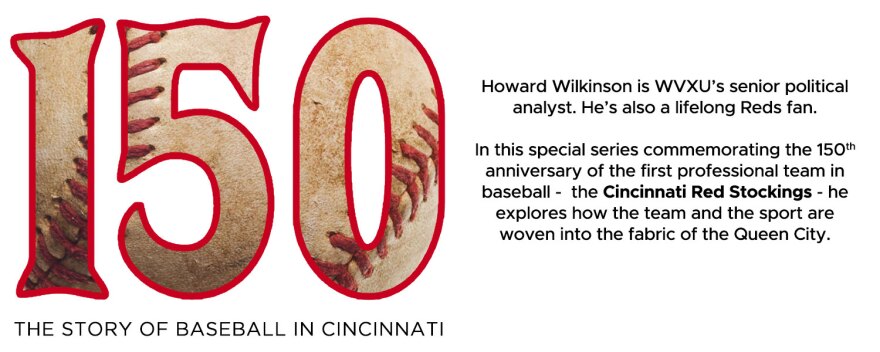The stands at Crosley Field were packed with 28,027 Reds fans on the night of June 24, 1970, the final game in the cozy, quirky ball park that had been the home of the Cincinnati Reds since 1912.
Crosley went out with a bang. And then a whimper from their opponents that night, the San Francisco Giants.
The Reds trailed the Giants 4-3 going into the bottom of the eighth inning. Then, Reds catcher Johnny Bench, who would end up winning the National League MVP award that year, hit a solo home run to tie the game. He was followed to the plate by "The Big Bopper," first baseman Lee May, who hit another home-run ball sailing off into the night sky over Cincinnati's West End.
Reliever Wayne Granger – who would become a member of the Reds Hall of Fame – faced the final Giants hitter, with two outs and the Reds leading 5-4. Bobby Bonds (father of Barry) grounded weakly to Granger, who tossed the ball on to May for the final out.
And that was the final at-bat at Crosley Field.
After the game, and the crowd had gone home carrying its memories of Crosley, some Reds executives and then-Cincinnati Mayor Gene Ruehlmann dug up the Crosley Field home plate, loaded it on a helicopter and flew it about three miles to the southeast where they put it in place at the nearly finished multi-sport Riverfront Stadium.
A piece of Crosley survived, for a while at least, at Riverfront Stadium.

For the next few years, the classic ball park at Findlay and Western avenues sat there falling apart. Its only use was as an auto impound lot for the Cincinnati police.
In the early 1970s, historic preservation was not the consideration it is today. On April 19, 1972, Pete Rose Jr., at the age of three, sat next to his dad and pulled a lever which sent a 7,000-pound wrecking ball into the right field wall.
Crosley Field was soon a pile of rubble.
But the memories live on in the hearts and minds of those who spent steamy summer afternoons or pleasant evenings at the ball park, watching their heroes.
You can see it today – just stop by the Reds Hall of Fame and Museum at Great American Ball Park. Watch the parents and grandparents standing over the pinpoint accurate model of Crosley Field with their children and grandchildren, passing on the lore of Crosley.
Four of those players who spent all of their years with the Reds at Crosley Field are now bronze statues on Crosley Terrace in front of Great American Ball Park – The Hall of Fame catcher, Ernie Lombardi, crouched behind the plate. A 15-year-old kid from Hamilton, Joe Nuxhall, on the mound firing a pitch to perhaps the greatest Red of them all, Frank Robinson, frozen in time in the middle of that sweet swing. And off to the side, waiting his turn at bat, the Reds' superstar of the 1950s, Ted Kluszewski, in the on-deck circle.
Before Crosley Field closed forever in 1970, baseball had been played at the corner of Findlay Street and Western Avenue since 1884. The first ball park on that site was known as League Park, but it burnt to the ground and was replaced by an ornate looking park with the memorable name of the Palace of the Fans.
The Palace of the Fans, parts of which are prominent in the Reds' logo for the 150th anniversary of professional baseball in Cincinnati, opened in 1902 and was torn down in 1911. It apparently looked nice, but wasn't particularly structurally sound.
The next year, Redland Field opened. That is the park we would recognize as Crosley Field. The name was changed in 1934 after business mogul Powel Crosley bought the team.
There are countless memories associated with that old ball park:
- Four games of the 1919 World Series, where the Chicago "Black Sox" were said to be throwing games for gamblers, were played at Crosley.
- On May 24, 1935, President Franklin D. Roosevelt flipped a switch in Washington and the towering light stands erected at Crosley Field bathed the field in light for the first night game in major league history.
- In Oct. 1940, the Reds won the seventh and deciding game of the World Series against the Detroit Tigers at Crosley, only a year after losing the World Series to the Yankees.
- On June 11, 1938, Johnny Vander Meer threw the first of his back-to-back no-hitters; the second came four days later in Brooklyn.
- Joe Nuxhall, a kid from Hamilton who was quite an athlete, faced Stan Musial and the St. Louis Cardinals in a game on June 10, 1944. He was absolutely hammered by the Cards. But, then again, he was only 15 years old, the youngest player in major league history. After eight years in the minors, Nuxhall returned to the Reds to become a popular pitcher and, later, a beloved radio broadcaster.
- On a non-baseball note, The Beatles played a quick concert on the field at Crosley before a packed house of screaming fans.
- And, in the waning days of the ball park, on May 17, 1970, it was the site of Hank Aaron's 3,000th major league hit.
Today, the City Gospel Mission sits on much of the site of Crosley Field. They have worked with the Reds Hall of Fame and Museum to create a walking tour that gives visitors a sense of what the old ball park looked like.
Old-timers who saw many a game there can do that walking tour and their minds' eyes can fill in the blanks. For them, that plot of land at Findlay and Western will always be hallowed ground.




